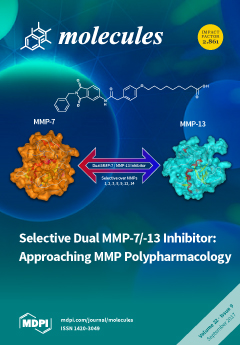A comprehensive study on essential oil and different solvent extracts of
Sideritis romana L. subsp.
purpurea (Tal. ex Benth.) Heywood (Lamiaceae) from Montenegro is reported. The gas chromatography-mass spectrometry analysis of the essential oil revealed a total of 43 components with bicyclogermacrene (23.8%), germacrene D (8%), (
E)-caryophyllene (7.9%) and spathulenol (5.5%) as the major ones. Sesquiterpenoid group was found to be the most dominant one (64.8%), with 19.9% of the oxygenated forms. In the crude methanol extract of the investigated plant, obtained by Sohhlet exraction, the total phenol content was 14.7 ± 0.4 mg of GA/g, the total flavonoids were 0.29 ± 0.03% expressed as hyperoside percentage, whereas the total tannins content was 0.22 ± 0.04% expressed as pyrogallol percentage. For the antimicrobial activity determination, the following microorganisms have been used: methicillin-susceptible
Staphylococcus aureus (MSSA (American Type Culture Collection (ATCC) 29213)) and methicillin-resistant
S. aureus (MRSA (clinical strain)),
Escherichia coli (ATCC 25922), carbapenem-susceptible
Klebsiella pneumoniae (clinical strain), carbapenem-resistant
K. pneumoniae (clinical strain) and
Candida albicans (ATCC 14053). The essential oil showed high potency against MSSA and MRSA, both at high (~5 × 10
5 CFU/mL) and low (~5 × 10
3 CFU/mL) inoculum. With respect to MSSA, the minimal inhibitory concentration (MIC) value was 0.307 mg/mL, with bactericidal activity obtained at 0.615 mg/mL, while, in the case of MRSA, the MIC and minimal bactericidal concentration (MBC) values were 0.076 and 0.153 mg/mL, respectively. Regarding anti-
Candida albicans activity, the MIC value was 2.46 mg/mL without reaching fungicidal activity. In addition to the observed essential oil efficacy, different solvent extracts were analyzed for their antimicrobial activity. Similarly to the essential oil, thehighest efficacy was observed against both MSSA and MRSA strains, at high and low inoculums, in the case of the 1,2-dichloroethane and methanol extracts. A potent fungicidal activity has been also found for the
n-hexane and 1,2-dichloroethane extracts. It can be concluded that
Sideritis romana L. subsp.
purpurea (Tal. ex Benth.) Heywood provides a wide range of application in different fields such as phytochemistry, pharmacology, toxicology or pharmacognosy.
Full article






